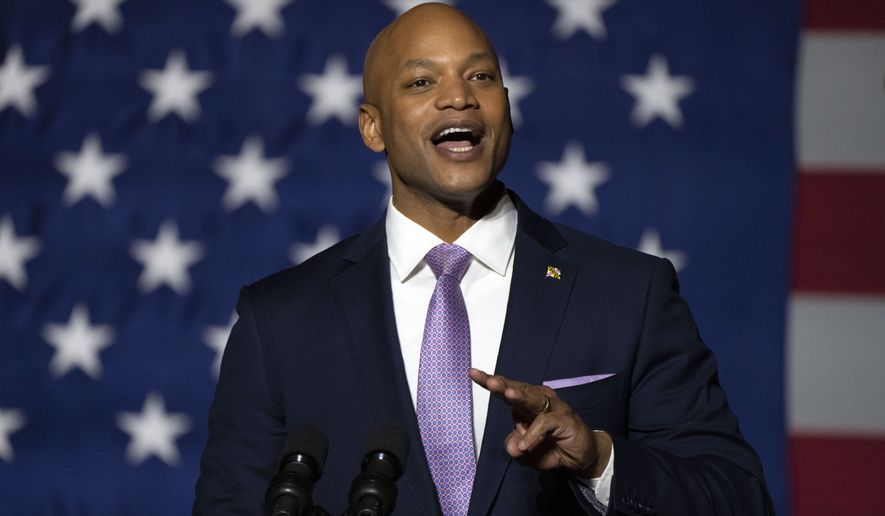
Maryland Gov. Wes Moore speaks before Vice President Kamala Harris, Wednesday, Feb. 22, 2023, in Bowie, Md., at Bowie State University. (AP Photo/Jacquelyn Martin)
Wes Moore’s plan to pay Maryland youth for a service year draws national attention, local criticism
Originally published in the Washington Times
Volunteerism is declining across the U.S., which is one reason that service organizations and political figures nationwide are closely watching Maryland Gov. Wes Moore’s experiment to pay young people with state tax dollars to work one year of service after high school.
AmeriCorps, the federal agency for volunteering and service, reported last month the first-ever U.S. decline in formal volunteering with organizations from 2020 to 2021, during the pandemic, when about 23% of Americans were volunteering. In 2018, that number was 25.3%.
Michael Smith, the CEO of AmeriCorps, has endorsed Mr. Moore’s service year proposal as a way to expand help for schools, seniors and the homeless. He said elected officials nationwide are paying attention and hoping to emulate the governor’s plan.
“As I’ve traveled across the country these past few months speaking with mayors and governors, teachers, students, all eyes are on Maryland,” Mr. Smith recently told state legislators in Annapolis. “People are inspired and excited about this new call to service coming from the governor. And I think if the last few years have taught us nothing else, it’s taught us that service to community and country is the light in the darkness.”
If approved by the legislature, the service year plan would essentially have the state find job placements for recent high school graduates at $15 per hour at nonprofits, private firms, unions, churches and other organizations. The state would pay a bonus of up to $3,000 to those who complete the year of paid service.
The proposal envisions 200 participants in the first year of the program and 2,000 by the fourth year. The governor has budgeted $18 million this year for the program and has created a Cabinet agency to administer it.
Mr. Moore, a Democrat who is two months into his term, is using rhetoric that sounds like an effort at social engineering. An Army veteran of the Afghanistan War and former head of a charitable organization in New York City, the governor portrays the proposal as a way to “save” Americans from hardship and from one another.
He said his service year model will “bring people together to serve under a common umbrella” in “this time of political divisiveness and this time of political vitriol.”
“It’s a bridge to be able to bring together different parts and different groups of our society,” Mr. Moore said. “That is the type of connection and that is the type of ‘stickiness’ that we know is going to help move our state forward.”
Conservatives say the government doesn’t work that way, nor should it.
“Absolutely not. That sounds like a lofty campaign narrative,” said Christopher Summers, president and chief executive officer of the Maryland Public Policy Institute, a right-leaning public policy think tank in Maryland. “The campaign is over, he won. Congratulations.”
Referring to conjecture that Mr. Moore, 44, could run for higher office someday, Mr. Summers said, “I think probably every proposal that we see out of Gov. Moore is going to be something that can be sold on a national level.”
Mr. Summer said taxpayers “should be very leery of government being involved basically in the labor market.”
“In terms of this sort of government social engineering, we’re not so sure what the effectiveness will be,” he said. “There’s a lot of vagueness in terms of what are the benefits versus the large expansion of government’s role in the labor market, and that’s what we should be very concerned about.”
He said of youth unemployment, “we have a labor market for that. And that’s what we should be putting our energy into: strengthening that labor market so there are more opportunities, not by government creating an opportunity.”
Supporters of the governor’s proposal want to expand the eligibility to include people who have been out of high school for more than two years along with juniors and seniors in high school. Even some supporters in the legislature have expressed concerns about the potential growth of a new program and how to measure its effectiveness.
Mr. Moore said the intent of his proposal “is to be expansive.”
“We will be partnering with organizations who are both public sector and private sector, governmental organizations, unions, where we want to have a wide variety of options that the students can choose from,” he told legislators last week. “Whether they choose to serve in working in the environment, whether they choose to work in early childhood education, whether they choose to work with veterans, whether they choose to work with animals, it will be completely their choice.
“We want all of our students to know that we want them to go into whatever field makes their heart beat a little bit faster,” the governor said. “And all we’re simply saying is let’s create additional pathways for them to be able to achieve exactly that.”
According to the AmeriCorps report on volunteerism, the state with the highest “formal volunteer rate” in the U.S. in 2021 was Utah at 40.7%, followed by Wyoming at 39.2%, Minnesota at 35.5% and Maine at 34.9%. The District of Columbia was tied with South Dakota at 34.2%.
In what is termed “informal helping,” in which people help as volunteers but don’t formally serve with a specific organization, the leading states were Montana (68.8%), followed by Nebraska, Maine, Delaware and Vermont (63.9%). Maryland did not rank in the top 10 in either category.
• Dave Boyer can be reached at dboyer@washingtontimes.com.





